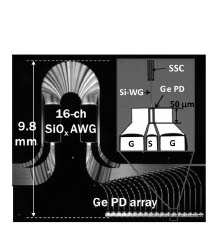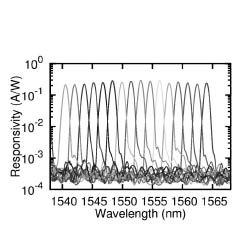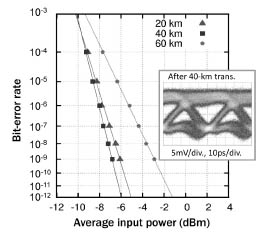Based on a Si-Ge-silica Monolithic Photonic Platform
Kotaro Takeda1,2, Yasuhiko Ishikawa3, Kazumi Wada3, and Koji Yamada1,2
1Nanophotonics Center, 2NTT Microsystem Integration Laboratories, 3University of Tokyo
Towards the next generation of broad-band optical networks, systems based on wavelength-division multiplexing (WDM) are being discussed to offer flexible bandwidth allocation, which contributes to energy-efficient network operation. Silicon (Si) photonics WDM receivers are expected to provide small, cost-effective photonic-electronic integrated circuits with multiple channels and functionalities. Recently, we have developed an integrated WDM receiver on our unique Si-germanium (Ge)-silica monolithic platform [1], and demonstrated long-distance signal transmission with the fabricated device.
Figure 1 is a top-view of a fabricated WDM receiver. The arrayed-waveguide grating (AWG) wavelength filter comprises silicon-oxide (SiOx) waveguides with a reflective index contrast of ~3 %. The waveguides are suitable for telecommunications applications because
of their low loss and small temperature and polarization dependence. The
AWG was connected to Si waveguides with the Ge photodetectors (PDs) using
spot-size converters [2]. The Ge layer was grown by the UHV-CVD method
[3]. SiOx and SiO2 layers for the AWG were deposited by the ECR plasma-enhanced CVD method,
in which the process temperature lower than 200 degrees Celsius ensures
that the AWG was constructed over the Ge layer without thermal damage.
The footprint is about 1 cm2. The insertion loss of the AWG is about 5.1 dB. The performance of Ge
PD is as follows: dark current of 245 nA at -2 V, responsivity of about
1.2 A/W, and 3-dB down bandwidth of over 15 GHz, which is sufficient for
over-20-Gbit/s data transmission. Figure 2 shows measured fiber-to-PD responsivity
spectra, including fiber-coupling loss. The responsivity is 0.29 A/W and
inter-channel crosstalk is -22 dB.
Next, we prepared 12.5-Gbit/s NRZ PRBS 231-1 signal and input it into standard single-mode fibers with dispersion
of 17 ps/km/nm at distances of 20, 40, and 60 km. After that, the signal
was input into the AWG-PD device by butt coupling of a high-NA fiber. Figure
3 shows measured bit-error rate (BER) curves for various distances and
a received eye pattern after 40-km transmission. We confirmed error-free
signal transmission up to 40 km. The receiver sensitivity measured at the
AWG input was -6.8 dBm for the BER of 10-9 after 40-km transmission. The experiment was performed at room temperature without thermal control. To the best of our knowledge, this is the first demonstration of long-distance signal transmission using Si photonic WDM receiver.
[1] H. Nishi et al., Opt. Express 20 (2012) 9312.
[2] T. Tsuchizawa et al., J. Sel. Top. Quantum Electron. 17 (2011) 516.
[3] S. Park et al., IEICE Trans. Elect. E91-C (2007) 181.
 |
 |
 |
||||||||
|
|
|